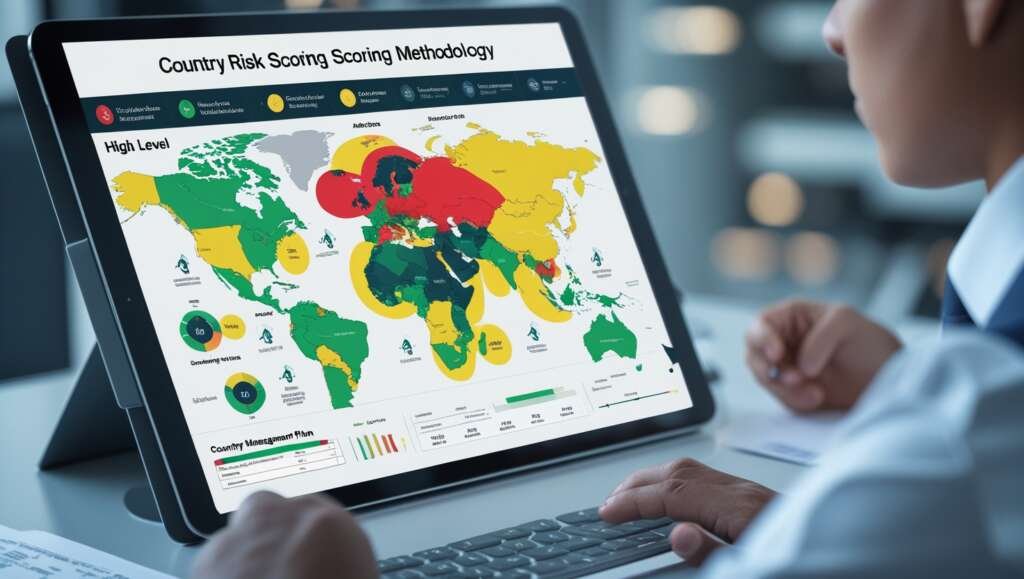How well does your business understand the risks tied to different countries? In today’s complex global financial system, accurately managing country-specific risks is essential—especially for sectors like virtual assets, banking, and financial services that face tight regulations. The ongoing battle against money laundering (AML) and terrorist financing (CFT) demands a solid framework to assess the risks posed by various jurisdictions. Using a structured country risk scoring model based on key international indicators, organizations can classify countries as high, medium, or low risk. This classification then guides how much due diligence is needed, ensuring the right level of scrutiny is applied depending on each country’s risk.
This article, the first in a two-part series, is designed to meticulously outline the foundational elements of a practical and adaptable framework for country risk scoring. It will focus on the critical and internationally recognized metrics that serve as the “pillars” of this assessment, providing a deep dive into each.
The Pillars of Country Risk Assessment: Foundations of a Robust Framework
An effective and reliable country risk scoring model is fundamentally built upon the analysis of several internationally recognized indicators. These indicators are carefully selected because they collectively reflect a jurisdiction’s inherent vulnerability to, and its capacity to combat, money laundering, terrorist financing, and various forms of corruption. Each pillar offers a unique lens through which to evaluate a country’s risk profile, and their combined assessment provides a holistic view.
-
FATF Ratings: The Global Standard-Setter and Its Influence
The Financial Action Task Force (FATF) is the leading global intergovernmental body dedicated to setting the international standards for combating money laundering, terrorist financing, and the financing of proliferation of weapons of mass destruction. Besides making these rules, FATF helps countries put them into action through strong laws, regulations, and operational measures designed to safeguard the integrity of the international financial system. One key part of FATF’s work is carrying out detailed reviews called mutual evaluations, where member countries check each other’s progress in following FATF standards. The results of these reviews are made public and shape how countries’ risks are viewed. Based on these findings, FATF publishes lists of jurisdictions that exhibit strategic AML/CFT deficiencies, which are broadly categorized as follows:
- FATF Blacklist (High-Risk Jurisdictions Subject to a Call for Action): These are the countries identified by the FATF as having profound and persistent strategic deficiencies in their AML/CFT regimes. They are deemed to pose a significant and ongoing high risk to the integrity of the international financial system. The FATF explicitly calls upon all members and non-members to apply enhanced due diligence measures to business relationships and transactions with individuals and financial institutions from these countries. In some cases, counter-measures may even be applied, which can include restrictions on financial transactions, enhanced reporting requirements, or even prohibitions on establishing new branches or subsidiaries. The implications for businesses engaging with blacklisted jurisdictions are severe, often leading to de-risking by financial institutions globally, making it extremely difficult to conduct legitimate transactions.
Currently, this list is very short, typically including countries like the Democratic People’s Republic of Korea (DPRK) and Iran, due to their severe and unaddressed deficiencies. Engaging with any entity or individual linked to these jurisdictions carries the highest possible inherent risk, often necessitating outright prohibition of transactions or requiring extreme caution and rigorous scrutiny to avoid facilitating illicit finance. The reputational damage alone for a business found to be dealing with such jurisdictions can be catastrophic.
- FATF Greylist (Jurisdictions Under Increased Monitoring): This list comprises countries that are actively working with the FATF to address identified strategic deficiencies in their AML/CFT regimes. While these jurisdictions have made a high-level political commitment to resolve their shortcomings within an agreed timeframe and are subject to increased monitoring by the FATF, they still pose an elevated risk compared to fully compliant nations.
The inclusion on the greylist signals to the global financial community that these countries have vulnerabilities that could be exploited for illicit finance. For businesses, engaging with greylisted jurisdictions demands a heightened level of vigilance. This often triggers enhanced due diligence procedures, though typically less stringent than those for blacklisted countries. The specific actions required by businesses might include more frequent risk assessments, deeper scrutiny of transaction patterns, and increased reporting obligations. The purpose of the greylist is to encourage these countries to swiftly implement their action plans, and progress is regularly reviewed by the FATF.
Examples of countries that have been on this list often include nations like Turkey, South Africa, or the UAE (it’s important to note that the UAE was recently removed from the greylist in February 23 2024, a testament to its significant progress in strengthening its AML/CFT framework, which directly impacts its perceived risk profile and demonstrates the effectiveness of the FATF process). Businesses must stay abreast of changes to the greylist, as a country’s removal signals improved risk, while addition necessitates immediate adjustments to compliance protocols.
- FATF Compliant/Largely Compliant: These are countries that have undergone the rigorous FATF mutual evaluation process and have been assessed as having robust and effective AML/CFT frameworks in place. They are deemed to largely or fully adhere to the FATF Recommendations, meaning their legal, regulatory, and operational measures are generally sound. These jurisdictions generally represent a lower inherent risk from an AML/CFT perspective, indicating a strong commitment to combating financial crime and a well-functioning regulatory and enforcement environment. For businesses, this translates to a more stable and predictable operating environment with reduced AML/CFT compliance burdens compared to higher-risk jurisdictions.
However, it is crucial to remember that while they are considered lower risk, a risk-based approach still dictates that ongoing monitoring and standard due diligence are applied. No country is entirely risk-free, and even compliant nations can have individual actors or specific sectors that pose risks. Furthermore, FATF’s assessments are dynamic; a compliant country today may face new challenges or deficiencies in the future, necessitating continuous monitoring by businesses.
-
Corruption Perception Index (CPI): A Barometer of Integrity and Governance
The Corruption Perception Index (CPI), published annually by Transparency International, serves as a crucial barometer of perceived public sector corruption across countries worldwide. It ranks nations based on how corrupt their public sectors are perceived to be by experts and business people. The index assigns a score from 0 to 100, where a score of 0 signifies highly corrupt, and a score of 100 indicates a very clean public sector. A country’s CPI score is a powerful indicator of its overall governance quality, the strength of its rule of law, the transparency of its institutions, and, critically, the prevalence of illicit financial flows. It reflects the extent to which public power is abused for private gain.
A higher perceived level of corruption, reflected by a lower CPI score, directly correlates with a higher AML/CFT risk. This is because widespread corruption often signifies a weaker enforcement environment, compromised regulatory oversight, and greater opportunities for illicit activities, including money laundering, bribery, and terrorist financing, to flourish undetected. In such environments, the lines between legitimate and illegitimate funds can become blurred, and the mechanisms designed to prevent financial crime may be undermined by officials who are complicit or easily influenced.
Corruption can facilitate the movement of illicit funds through various channels, including shell companies, complex ownership structures, and trade-based money laundering. It also damages public trust in governments and institutions, making it harder to collect useful information and catch financial criminals. For businesses, working in countries with high corruption levels raises the chances of facing bribery, extortion, and unknowingly helping with money laundering through transactions that appear legal.
Conversely, countries with higher CPI scores (less perceived corruption) are generally considered to have stronger institutions, more transparent governance, and a lower inherent risk of illicit financial activity. They tend to have more effective anti-corruption agencies, independent judiciaries, and robust regulatory frameworks that deter and punish corrupt practices, thereby strengthening the overall AML/CFT ecosystem.
-
Sanctions Regimes: The Red Flags of Global Finance and Geopolitical Risk
International sanctions represent powerful political and economic measures imposed by individual countries (such as the United States’ Office of Foreign Assets Control – OFAC), blocs of nations (like the European Union – EU), or international bodies (such as the United Nations – UN) against targeted states, specific entities, or designated individuals. Common reasons for imposing sanctions include combating terrorism, halting nuclear programs, addressing human rights violations, and promoting peace or democracy. Sanctions are key tools in managing geopolitical risks and upholding global security and law.
When a country appears on a major sanctions list, or has deep financial or political ties to blacklisted entities or individuals, it becomes a high-risk jurisdiction. Dealing with such countries or persons can bring major legal, financial, and reputational consequences. Businesses must either avoid such dealings entirely or manage them with strict controls. The type and scope of sanctions directly impact how risky a jurisdiction is, especially in regulated sectors like finance.
- Comprehensive Sanctions: Comprehensive sanctions are broad bans that limit nearly all forms of economic activity with a sanctioned country. These often include trade, investment, banking, and even travel. Such measures indicate very high risk and usually mean businesses must fully cut ties with that jurisdiction. For example, the U.S. has maintained comprehensive sanctions against countries like Cuba, Iran, and Syria, severely limiting economic engagement. Non-compliance with comprehensive sanctions can result in massive fines, criminal charges, and exclusion from the global financial system. Businesses must also be aware of “secondary sanctions,” which can target non-U.S. persons for engaging in certain activities with sanctioned entities, even if those activities do not involve a U.S. company.
- Targeted Sanctions: These are more specific measures aimed at particular individuals, entities, or sectors within a country, rather than the entire economy. They are designed to minimize harm to innocent populations while maximizing pressure on the targeted regime or actors. While significant, they do not necessarily prohibit all economic engagement with the country. However, they demand proper screening, continuous monitoring, and a deep understanding of the specific restrictions. For instance, sanctions might target specific government officials, military units, financial institutions, or industries (e.g., energy, defense). Targeted sanctions indicate a medium-high risk, as they still carry substantial compliance burdens and potential for severe penalties if violated. Businesses must implement robust screening mechanisms to identify sanctioned individuals or entities, including those owned or controlled by sanctioned parties (the “50% Rule” in some jurisdictions, where an entity is considered sanctioned if 50% or more is owned by a sanctioned person).
- Minor/Limited Sanctions: In some cases, sanctions might be very specific, targeting only a handful of individuals or entities with limited broader economic impact. While these still require careful monitoring and screening against relevant lists, they generally indicate a lower level of inherent country risk compared to comprehensive or widespread targeted sanctions. These might involve asset freezes on a few individuals or travel bans.
- No Significant Sanctions: Countries not subject to any major international sanctions regimes are generally considered lower risk from this perspective. However, even in such cases, businesses must remain vigilant for any new developments or the imposition of new sanctions, as the geopolitical landscape can shift rapidly. The global nature of financial crime means that even a country not directly sanctioned could be used as a conduit for funds linked to sanctioned parties.
-
Basel AML Index: A Composite and Holistic Risk Indicator
The Basel AML Index, developed by the Basel Institute on Governance, offers a sophisticated and independent ranking that assesses countries’ inherent money laundering and terrorist financing risks. What makes the Basel AML Index particularly valuable is its composite nature. It is not based on a single data point but rather aggregates and synthesizes information from a diverse array of publicly available and credible sources. These sources include, but are not limited to, FATF mutual evaluation reports, Transparency International’s CPI, various World Bank governance indicators (such as Government Effectiveness, Regulatory Quality, Rule of Law, and Control of Corruption), and other relevant data on financial transparency, judicial independence, and regulatory effectiveness.
The index provides a single, quantifiable score, typically ranging from 0 to 10, where a score of 10 represents the highest possible risk of money laundering and terrorist financing. This comprehensive, multi-faceted approach makes the Basel AML Index an exceptionally valuable tool for a holistic risk assessment, as it captures a broader spectrum of vulnerabilities than any single indicator alone. It looks at both the strength of a country’s AML laws and how well they are actually enforced to illicit financial activities, considering both its legal and institutional frameworks and the practical effectiveness of their implementation.
For example, a country might have strong AML laws on paper (which FATF might assess favorably), but if its judicial system is weak or corrupt (reflected in the CPI and World Bank indicators), the Basel AML Index would capture this disconnect, assigning a higher overall risk score. This makes it a powerful tool for businesses seeking a quick yet comprehensive overview of a country’s AML/CFT risk landscape. Its independence and reliance on publicly available data further enhance its credibility and utility in global compliance programs.




